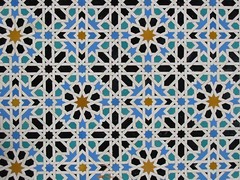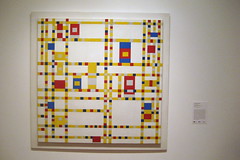Lines
vary by the width of drawing tools and designs
Shape
|
شكل
|
circles,
squares, triangles, polygons, etc.
Color
|
لون
|
the
hue of a color as in red, yellow, or blue, etc.
Value
|
قيمة
|
the
amount of dark or light tones or shades
Form
|
شكل -
صورة
|
the
complete three-dimensional or 3D makeup that composes the structure. A form may be made of different parts and shapes. A table may have shapes of round legs and a square or rectangular-shaped top but its total form is that of a table. The human body has different parts and shapes that combine to give us our form.
Texture
|
نسيج
|
the
surface quality that may vary from smooth as with glass or marble to rough or
soft as in a carpet.
Space
|
فضائي
|
the
relation of open and closed space that may be experienced or represented.
Balance: evenness of composition or of certain elements
|
توازن
|
 |
Contrast: the difference and relative amount of dark and light
values
|
تضادّ ، تبايُن
|
 |
Iconology: the study of symbolism and meaning in art. In the
example shown on the other side, what is the difference in the symbolic
representation of the two birds?
|
عِلم الأيقونات
|
 |
Movement: the sense or impression of movement, speed or pace
|
حركة
|
 |
Pattern: the texture, lines or other repeated motifs of
artwork
|
عنصور زخرفيّ
|
 |
Perspective: the science and art of arranging compositions
with correct alignment of depth perception. The arrangement uses a vanishing
point of perspective for all objects in relation to the viewer.
|
عِلم المنظور
|
 |
Proportion: A principle
of art and architecture: the ratio and relations of elements in an artwork or
in the design of architecture, as in columns or other building parts
|
التَّناسُب
|
 |
Rhythm: the sense of movement, pace and direction given to a
work of art - a term borrowed from music
|
إيقاع
|
 |
Symmetry: the evenness and balance of the elements art or
architecture
|
التَّقابل ، التَّناظر
|
 |
Unity: the wholeness and linkage of elements together into a
unified or complete composition
|
إتِحاد
|
 |
Architectural Term
|
Arabic
|
Meaning
|
|
Banco Architecture
|
Mud or earth based
architecture used in Mali
|
||
Column
|
عمود
|
A tall supporting
structural pier, usually round that supports
the roof or upper walls or floors of building, as in a mosque
|
|
Maqsura
|
مقصورة
|
System of projecting niches used
for zones of transition and for architectural decoration.
|
|
Mihrab
|
محراب
|
The niche in the
Qibla wall that marks the direction of prayer facing toward Mecca
|
|
Minaret
|
مئذنة ، برج - منار و منارة
|
Tower-like structure usually associated with
mosques or other religious buildings.
|
|
Minbar
|
منبر
|
A pulpit or
elevated platform with a stair from which the Imam may lead a service in the
mosque
|
|
Muqarnas
|
مقرنص
|
System of projecting niches used
for zones of transition and for architectural decoration.
|
|
Post and Lintel
|
a simple form of construction where a horizontal
member (the lintel—or header) is supported
by two vertical posts at either end.
|
||
Qibla
|
قِبلة
|
Direction of Mecca which determines the direction
of prayer.
Definition
The qibla is the prime factor in the orientation of mosques and
is usually marked by a mihrab (or more in India).
|
|
Qubba
|
قبة
|
Literally 'dome,' often used to refer to a domed
mausoleum which contains the grave of a saint or some important personage.
|
|
Sabil / Sebil
|
Turkish term for a drinking fountain. Also
used to refer to a small kiosk with attendant who dispenses water, or
sherbet, from behind a grille.
|
||
Sahn
|
صحن
|
Courtyard of a
mosque
|
|
Squinch
|
حِنية
|
Small arch in the corner of a building that
converts a square space to an octagonal area which may then be covered with a
dome.
|
|
Stucco
|
جِبس
|
Decorative plasterwork used in architecture.
Definition
Stucco
is primarily an invention of the Iranian world where it was used in the
absence of suitable stone for carving.
|